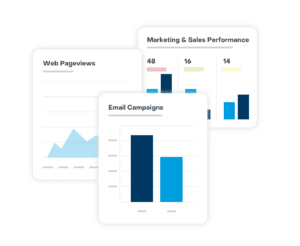How to Measure Your Marketing Campaign Effectiveness
As a marketer, you are happy with your campaign since you’ve spent months planning and executing. Your prospects opened and clicked your email. You started building a relationship based on your business culture and philosophy. You nurtured your relationship, demonstrating value through your content—blog articles, emails, webinars. As trust deepens, the probability of buying from you increases. You’ll have to recognize when your prospects are in “buying mode.”
But what do you do when your campaign is over? On to the next?
Not so fast! Far too often, we dedicate hours upon hours to planning and executing campaigns, never to measure whether our efforts paid off. Do you know your campaign’s effectiveness? Do you have any ROI or other metrics to show your leadership team or learnings to apply to the next campaign?
Why Do You Need to Measure Your Efforts?
Your work is done. Now it’s time to learn from it. With change being the only constant, you must always measure your campaign’s results to know what is working and what isn’t. Here are some questions you need to answer:
- What impact did your campaign have? You now have access to real-time data, which allows you to define how effective your marketing strategy was. For example, how did your campaign influence lead generation and conversion? What was the ROI? Answering these questions is not only essential in helping your marketing team make more informed decisions the next time around, but it also provides you with information that your leadership team wants to know.
- What worked well? You need to figure out what you did to have positive results. Did you have any specific messages that resonated particularly well? Any new tactics that proved beneficial? Or did you correctly configure your buyer persona? If you understand what worked best, you can then use this knowledge to improve future campaigns.
- What didn’t work so well? On the flip side, you also need to determine what didn’t seem to work for you. Not everything you do will be a homerun, and that’s fine. When something doesn’t work well, it’s an opportunity to find out what you should avoid in the future or what to improve upon.
What You Should Measure (and How to Do It)
Overall the marketing effectiveness of your campaign will be measured by the short-term and long-term increase in revenue, and by your company’s costs of customer acquisition.
Now that you’re sold on the importance of measurement, what exactly do you need to measure? Some metrics focus on branding and some on-demand generation. Let’s say you’re running an email marketing campaign. Here’s a list of the four key deliverability metrics you should be tracking, why they’re important, and how they can help you improve your reach and effectiveness.
Bounce Rates
High bounce rates will negatively impact your sender reputation. A poor sender reputation can cause email providers to push you to a junk or spam folder instead of the inbox. It can also lead to you getting blacklisted—the worst possible outcome for an email marketer.
If you notice spikes in your bounces over time, this could indicate a data issue, so you need to take a good, hard look at your database. It may be time to clean out old addresses, unknown users, and stale contacts.
Open Rates, Click-Through Rates, and Engagement
Low engagement will be considered a negative signal, so it’s essential to monitor these rates over time and use them to improve components like subject lines, body copy, and calls-to-action.
Removing contacts who are completely disinterested in your content, such as those who don’t open any of your emails over a long time, will help prevent an internet service provider (ISP) from misidentifying you as spam. Marketing automation platforms, such as Sugar Market, leverage AI-based scoring models to uncover which of your prospects are more likely to engage with your campaigns.
Unsubscribe Rate
Be sure you have set your managed preference center to help contacts opt-down and choose what messages they’d still like to receive instead of completely opting out of your email programs. However, some contacts will want to unsubscribe from your list altogether.
If you monitor your unsubscribe rates over time, and by source, you’ll gain insight into what’s working and what isn’t so you can make necessary adjustments. Look for trends in your unsubscribes lists. Do you have a problem with a particular message, subscription source, or list? Use this metric to identify unsubscribe triggers so you can guard against them.
Inbox Placement Rate
Even if your email doesn’t bounce, it may not be delivered into the inbox. It’s important to measure and compare your delivery rate to your inbox rate. Some of your emails could be hitting spam folders. You won’t know how many until you run an inbox placement analysis. Additionally, if your spam rates increase over time, this could prevent future mail from reaching prospects and customers.
This is an important metric you can use to make sure your emails are reaching their desired recipients. Otherwise, you’ll spend a lot of time and money developing content that has very little impact on revenue.
If your emails include links to gated content, you might also want to measure how many people (and who) filled out the form to download the content, as well as who viewed it.
If you included an invite to a webinar or other event, you could measure how many people (and who) registered and then attended.
In short, you need to think beyond the confines of the campaign itself—put yourself in your customer’s shoes, think about the path the campaign led them, and follow it to see what happened.
What’s the key to unlocking these metrics, you may be wondering? You can leverage the same marketing automation platform that you used to configure the campaign for measuring its effectiveness as well. Metrics are a key component of marketing automation; it’s simply a matter of reviewing reports and dashboards that display relevant information and then referring to that data regularly.
Closing Thoughts
Monitoring trends in these four areas can have a significant influence on your success as a marketer. Changes can signal a problem, leading to a much faster resolution than if you’re unaware of issues altogether. If they go unresolved and amplify, they’ll become much more difficult to resolve later.
If you’re unsure how to monitor these statistics, reach out to your marketing automation provider. Many, like Sugar Market, offer deliverability consulting services to help you monitor these aspects of your email campaigns. If you would like to optimize your email deliverability rates, feel free to reach out to us!




